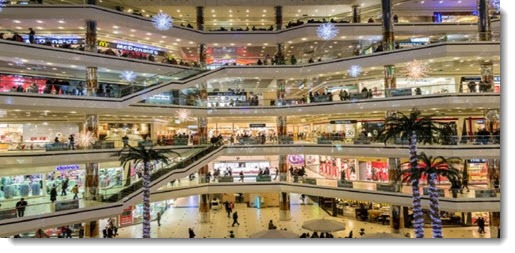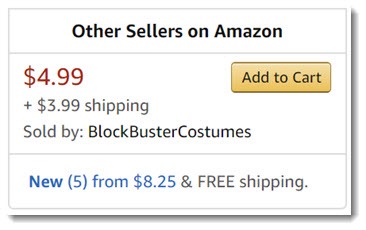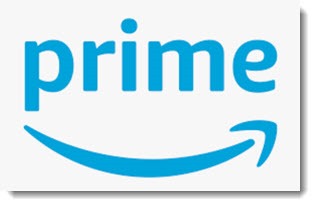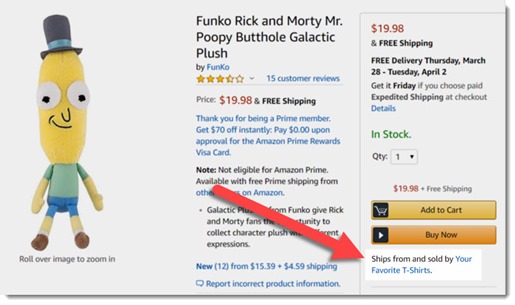
Amazon has become an infinitely large mall full of small shops. More than half of the stuff sold on Amazon worldwide in 2017 came from third-party sellers. More than 2,500,000 small and medium-sized businesses sell through Amazon Marketplace.
Amazon was founded in 1994 as a large and well-stocked bookstore, something like Barnes & Noble but with a much larger book selection on the virtual shelves.
When it branched out into other retail products – clothing, toys, electronics, and the rest – Amazon became basically a large and well-stocked box store, like going into Walmart but again with a much larger selection.
In the last few years, Amazon has quietly changed its business and become something much more than a single big store.
I don’t have any advice today. This is just an interesting thing to know about the world.
Amazon Retail is what you think of as shopping at “Amazon.” It’s all Amazon. Amazon buys products from manufacturers, stores them in Amazon warehouses, handles the sale on its website, ships the packages to you, and handles customer complaints and returns. Those sales have made Amazon the most valuable retailer in the United States by market cap.
In last year’s shareholder letter, Jeff Bezos revealed that those sales now account for less than half of the products ordered and shipped through Amazon. The rest are processed on behalf of small and medium-sized businesses through Amazon Marketplace.
It turns out anybody can sell anything on the Amazon website. The shopping experience is basically the same but there are interesting stories behind the scenes to explain why some products qualify for Prime shipping and others don’t, and why so much is “sold by and ships from” unfamiliar names.
Bezos said that there were more than 300,000 new third-party sellers on Amazon in the US alone in 2017; there are estimates that more than 200,000 sellers have achieved $100,000 in annual sales and there are more than 24,000 with $1 million in sales.
You’re not meant to notice the whole “Amazon Marketplace” thing. This isn’t something mysterious. It’s all done at the Amazon.com website.
It’s easy to overlook the small print on Amazon about who will fulfill your order. Amazon wants our experience to be the same regardless of who handles the order. The product pages, the shipping options, and the checkout process are all largely the same. It’s only different on the back end — who’s offering the product, who’s getting paid, who’s doing the fulfilling and shipping, and so on. Amazon handles the customer relationship; you’re always at a distance from the real seller.
Amazon is wildly successful at attracting shoppers – more than half of all online shoppers go straight to Amazon to search for something to buy, instead of doing a Google search. Amazon is such a dominant force behind all commerce today that almost every business selling products is under pressure to join Amazon Marketplace. Amazon makes it easy for sellers to get started on Amazon Marketplace, far easier than setting up a website from scratch and investing in the infrastructure for warehousing and shipping. Amazon Marketplace sellers pay a hefty commission, averaging 15%, but millions of businesses have decided that it’s worth it to have access to Amazon’s unparalleled customer reach.
Amazon Retail, then, is the big box store at one end of the mall. If you left the big store, you would see hundreds of thousands of small Amazon Marketplace stores stretching into the distance. Fortunately you don’t have to walk; you don’t even have to know which store to go into. Instead, you look for a particular product and Amazon directs you to all the sellers with that product.
Amazon decides how sellers will be ranked when you do a search. Just like Google, there is fierce competition to be listed high in Amazon search results.

Even more powerfully, when multiple sellers sell the same item, Amazon determines which one is the default whose price is displayed and whose item is added to the cart. Most of us never click on the right where it says “Other sellers on Amazon.” The sellers’ names are meaningless to us and we will never develop any loyalty to one over another, so the system strongly incentivizes sellers to get to that default position by undercutting each other on price, to the point where profits disappear. And you can imagine the impact when Amazon decides to sell its own house brand and give it the preferred position in search results, frequently without any indication to the customer that the products are house brands. Costco uses the name Kirkland consistently for its house brand products. Amazon has more than 125 private label brands and gives you no easy way to tell that it is actually responsible for Franklin & Freeman dress shoes, North Eleven ponchos, Pinzon shower curtains, and Mama Bear diapers.

Amazon has many signals to steer our shopping decisions – “Amazon’s Choice” and “Best Seller” badges, coupons, and the like – but the Prime logo is the most powerful. Amazon has over 100 million Prime subscribers in the US alone, and they are strongly motivated to buy items marked as Prime to get the “free” two-day shipping. There are two different ways to join Amazon Marketplace, and only one of them gets the advantage of the Prime logo.
* PRIME Third parties can sign up with Amazon Marketplace and agree to send their inventory to be stored in Amazon warehouses. When you order a product, Amazon pulls it from the shelf and ships it to you. The whole “Marketplace” idea is meaningless to you in this case; why should you care whether the product was bought wholesale by Amazon or by some small business? It makes a big difference to the seller, which has to invest in inventory and pay a hefty fee to Amazon for the privilege of having Amazon store it and ship it – but the seller gets that “Prime” logo, which drives sales.
* NOT PRIME About half of the third parties list their products on Amazon.com without sending anything to the Amazon warehouse. Amazon takes the order and sends it on to the business, which is responsible for having items in stock and shipping them to you. Amazon enforces lots of policies for your benefit, insisting that sellers meet their shipping promises and honor Amazon’s policies on returns, but in the end Amazon is just taking the order; it’s up to the seller to deal with returns, complaints, and shipping issues. The risk goes up, however slightly, that you’ll receive counterfeit goods or deal with someone unreasonable. These businesses don’t get the treasured “Prime” logo.
The stakes are huge for sellers and the world is filled with nasty bits, so you know there are lots of dark places behind the scenes. Here’s an interesting description of the dirty tricks played by sellers against each other, trying to get competitors suspended by Amazon. And Amazon has a serious problem with counterfeit items for sale, with no easy way for sellers to complain to Amazon about fakes that are undercutting the prices of the real items. A cottage industry has sprung up to advise businesses caught in Amazon’s bureaucracy.
Want another example of a complicated world? There are many meta sellers on Amazon who don’t actually have any inventory anywhere. When you place an order, they order from other websites or other Amazon members, then mark up the price to you from 50% to 100%. Some of these meta sellers have millions of products listed and their Amazon statistics make them look credible.
The good news for us is that Amazon is focused on making customers happy. Millions of sellers, ranging from individuals to multi-million dollar businesses, sell products on Amazon, yet Amazon delivers the same buyer experience each time, no matter the seller. Welcome to the infinite mall!

